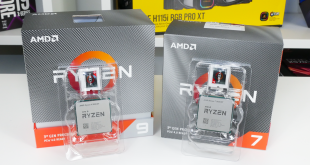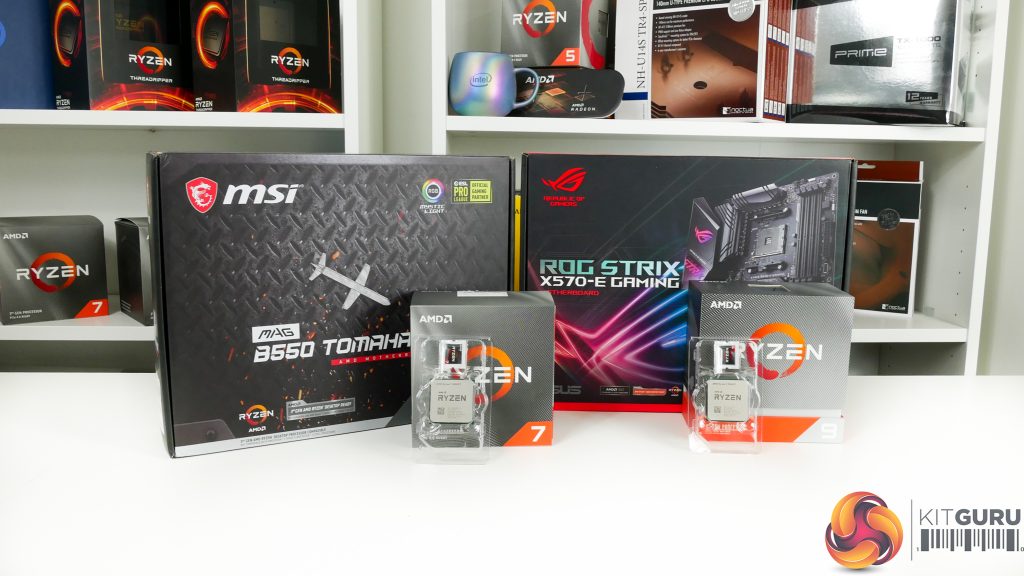
AMD is launching new, higher-frequency Ryzen 3000XT processors codenamed ‘Matisse 2’. Core to the upgrades versus the Ryzen 3000X processors they will co-exist alongside are increased maximum boost frequencies and the promise of enhanced boost clock residency.
We also see sizeable improvements in manual overclocking capabilities when pushing all-core frequencies, but let’s not get ahead of ourselves just yet.
Three individual processors will form the Ryzen 3000XT line-up. There is the six-core Ryzen 5 3600XT, eight-core Ryzen 7 3800XT, and twelve-core Ryzen 9 3900XT. We are examining the 3800XT and 3900XT in this review, but make sure you check back for Ryzen 5 3600XT coverage.
Worth noting is that there are no plans for a Ryzen 9 3950XT 16-core chip according to AMD; the Ryzen 9 3950X will stay as the current king of the hill for AM4.
Put simply, the Ryzen 9 3900XT and Ryzen 7 3800XT are simply frequency tuned versions of their Ryzen 9 3900X and Ryzen 7 3800X sibling. The new XT processors come in at the same MSRP as the 3900X at $499 USD and the 3800X at $399 USD.
Everything also looks similar – you get the same number of cores, the same amount of cache, the same 105W TDPs. They also drop into the tried-and-tested AM4 platform, albeit with a BIOS update for older motherboards.
Where the chips differ, however, is in terms of their clock speeds. The 3900XT sees a 100MHz increase to its maximum boost clock versus the 3900X and the 3800XT improves by 200MHz over the 3800X. That means that both of these XT chips ship with a maximum boost frequency of 4.7GHz which is as high as we have seen from Ryzen 3000 Zen 2 – a crown that was previously held by the Ryzen 9 3950X solely.
So how exactly has AMD managed to improve boost frequencies whilst keeping all other operating characteristics identical? Through optimising and tuning the manufacturing process.
Technically, the Ryzen 3000XT processors use the same TSMC 7nm process technology that the original Ryzen 3000X Zen 2 processors have used since day 1. There’s no application of N7P or any of TSMC’s other, more advanced, nodes with the XT chips. These use the same 7nm process but AMD highlights how they managed to tweak and optimise the processors’ design and manufacture in order to provide more favourable V-F curves.
AMD was keen to point out that this should translate into the same performance at slightly better power levels or slightly higher performance results thanks to improved frequency capability. The Precision Boost 2 algorithm still plays a pivotal role, especially in the case of the 12-core 3900XT which will still be power limited at its maximum 142W package power allocation.
Higher clock speed capability, drop-in AM4 upgrades, and the same Zen 2 goodness as usual – what’s not to like?
Well, for one, the eight-core and twelve-core versions now omit the Wraith cooler that ships with the 3900X and 3800X siblings. While this is unlikely to be anything of a real disappointment to most enthusiasts who buy an eight- or twelve-core AMD processor, it does provide slightly less value from the package when the X and XT MSRPs are identical.
And the other challenge currently is the real pricing of the processors. Despite being sold, officially, for the same MSRPs, the Ryzen 9 3900X and Ryzen 7 3800X are consistently available for around £60 less than their XT siblings.
The 12-core 3900X is around £440 going rate in the UK whereas the 3900XT will be £499.99 at launch. The 8-core 3800X is around £330 going rate in the UK (with the slower, lower-TDP 3700X even cheaper at £290) whereas the 3800XT will be around £389.99-£399.99 at launch.
Of course, these are just launch prices and we may see further movements in the coming weeks. But at a price increase of more than 10% for both the 8-core and the 12-core, it is going to be difficult to overlook the value of the non-XT siblings that will co-exist in the market.
Of course, that is unless the frequency improvements and overclocking capabilities show strong improvements with the optimised XT processors. Without further ado, let’s see if that is indeed the case…
 KitGuru KitGuru.net – Tech News | Hardware News | Hardware Reviews | IOS | Mobile | Gaming | Graphics Cards
KitGuru KitGuru.net – Tech News | Hardware News | Hardware Reviews | IOS | Mobile | Gaming | Graphics Cards






